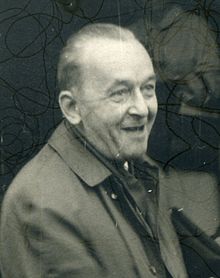Horst Herrmann (mathematician)
Max Horst Herrmann (born July 10, 1906 in Dresden , † November 17, 1973 in Hanover ) was a German mathematician and university professor.
Life
After graduating from the König-Georg-Gymnasium in Dresden on March 17, 1926, Herrmann studied mathematics, physics and chemistry at the TH Dresden (1926-1927) and the University of Göttingen (1927-1931) as a scholarship holder of the German National Academic Foundation . After the state examination on November 14, 1930 , he received his doctorate in 1932 with the work Contributions to the theory of eigenvalues and eigenfunctions with Richard Courant . After working as a trainee lawyer and assessor in Dresden, he entered the school service in Zittau in 1936 . In 1937 he joined the NSDAP . In 1940 he became a teacher. With the beginning of the probationary period (1933) he became a member of the Association for the Promotion of Mathematics and Science Education . After this association was incorporated into the National Socialist Teachers' Association (NSLB), he became a Gau administrator for mathematics in Saxony in 1938. From 1939 to 1945 he did military service, most recently as a government building officer for the reserve in the Army High Command . After the end of the war, after a short American captivity, he took up residence in Unterlüß, Lüneburger Heide, and from 1949 worked as an assistant at Fritz Rehbock's chair at the Technical University of Braunschweig until he was banned from doing so due to his Nazi past. After working as a lecturer and after his denazification (category V), he became a teacher at the Braunschweig evening school in 1949 and switched to the Kleine Burg school for girls in 1950. In 1952 he became a teacher again.
Herrmann completed his habilitation in mathematics in 1952. As part of a teaching assignment, he gave lectures on "Graphical Methods in Practical Mathematics". At the same time he began to construct electrical and electronic computing devices at the Institute for Applied Mathematics and from 1954 also held exercises and practical courses. In 1957 he was given leave of absence from school to take over the position of chief mathematician at the computer center established there at the Technical University of Braunschweig. He took over the procurement of an analog computer funded by the DFG called General Purpose Analogue Computer from Short Brothers and Harland and a Zuse Z22 digital computer . At that time, the analog computer was the first industrial electronic analog computer system in Germany and was visited by numerous representatives from industry and universities. The Z22 was the first digital computer in West Germany to be made available to universities and research institutions for teaching and research purposes. In 1959 Herrmann was appointed as an adjunct professor for computer technology at the Technical University of Braunschweig, and in 1962 he founded the Institute for Computer Technology and became its director. In the same year, an Electrologica X1 was purchased under his leadership . At the same time, he was head of the data center until his early retirement in 1971 for health reasons .
Herrmann was one of the pioneers in the field of the construction and application of program-controlled computing systems and, alongside Hans-Otto Leilich and Ernst Henze, was one of the founding fathers and advocate of the establishment of the computer science course in 1972 at the TU Braunschweig.
Publications
- Contributions to the theory of eigenvalues and eigenfunctions. Dissertation. University of Göttingen, 1932, OCLC 8932233 .
- Contributions to the morphology of the configurations. Habilitation thesis, TH Braunschweig, 1952.
- Exercises in projective geometry (= textbooks and monographs from the field of exact sciences. Mathematical series. Volume 18). Birkhäuser, Basel 1952, OCLC 154161966 .
- Structural properties, figure matrices and dissections of projective configurations. In: Mathematical-physical semester reports on maintenance d. Connection v. School and University. Volume 3, Vandenhoeck & Ruprecht, Göttingen 1953, pp. 90-115.
- Contributions to programming technology for electronic analogy calculating machines. In: Treatises of the Braunschweigische Wissenschaftlichen Gesellschaft. Volume 10, Braunschweig 1958, pp. 117-149. ( PDF, online )
literature
- Christine Pieper: University Computer Science in the Federal Republic and the GDR until 1989/90 . Steiner, Stuttgart 2009, ISBN 978-3-515-09363-7 .
Web links
- Institute for Scientific Computing at the TU Braunschweig
- Horst Herrmann in the Mathematics Genealogy Project (English)
- Herrmann, Max Horst. Short biography on the website of the German Mathematicians Association (PDF)
Individual evidence
- ^ Personnel file Horst Herrmann, TU Braunschweig.
- ↑ Herrmann, Max Horst. Short biography on the website of the German Mathematicians Association (PDF).
- ↑ a b Jörg Munzel: The development of computer science at the TU Braunschweig. In: W. Kertz (Ed.): Technical University of Braunschweig: from the Collegium Carolinum to the Technical University. Olms, Hildesheim 1995, pp. 701-709.
- ^ Developments at the TU Braunschweig before 1972. (PDF) In: 25 years of computer science at the TU Braunschweig. itec.kit.edu, p. 54 , archived from the original on June 13, 2010 ; accessed on August 11, 2016 .
- ↑ Hans-Dieter Ehrich and others: 40 years of computer science at the Technical University of Braunschweig 1972–2012. (= GI Edition Lecture Notes in Informatics. Vol. 6). 2012, ISBN 978-3-88579-425-7 .
| personal data | |
|---|---|
| SURNAME | Herrmann, Horst |
| ALTERNATIVE NAMES | Herrmann, Max Horst (full name) |
| BRIEF DESCRIPTION | German mathematician and university professor |
| DATE OF BIRTH | July 10, 1906 |
| PLACE OF BIRTH | Dresden |
| DATE OF DEATH | 17th November 1973 |
| Place of death | Braunschweig |
